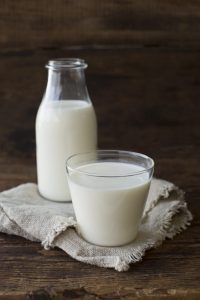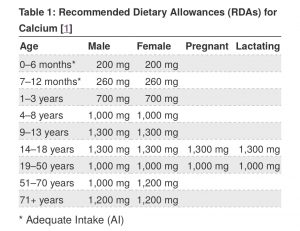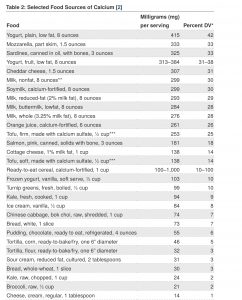Babies begin life drinking only milk. Whether breast or formula milk, all babies drink milk only until around 4 to 6 months of life. After a baby starts on solid food, milk is still regarded as his primary source of nutrition until 12 months of life. Most infants average between 600ml and 1000ml of milk per day (20-30oz). So why is it that so many children seem to stop taking milk entirely at around 3 years of age?

How Much Calcium Does My Child Need?
For some, it is because parents just don’t think it is important anymore. After all, their child is taking a variety of other foods. For others, it is a conscious choice to avoid dairy. Dairy has been blamed for a variety of different problems, ranging from eczema and allergic reactions to behavioural issues. Some people believe dairy increases sinus congestion, or is generally inflammatory. However, little to no robust scientific data exists to support these claims.
Why Do We Need Calcium?
Dairy has existed in the diets of most cultures for around the last 8,000 years, so this would appear to be a useful part of our diet. Dairy is a nutritional powerhouse, containing high levels of protein, vitamins and minerals such as calcium, phosphorus, magnesium, etc. There are few, if any, foods that can match its ability to provide such a complete nutritional package.
Various studies have linked dairy (particularly full fat dairy) to a reduction in obesity and diabetes type II risk. There is also evidence that high protein dairy such as milk and yoghurt help to reduce risk of cardiovascular disease. Dietary intake of dairy also reduces risk of certain cancers such as colorectal cancer.
Dairy has long been known to reduce the risk of osteoporosis in later life. Risk of osteoporosis is linked to calcium intake within the first 30 years of life, as this is the period of maximum bone growth. People with high dairy intake within the first few decades have improved bone density, and reduced risk of bone fractures in later life.
How Much Calcium Does My Child Need?
As you can see from the table above, children continue to require high levels of calcium after infancy, and after the traditional age of weaning.
Let’s take a look at some of the most plentiful dietary sources of calcium:
As you can see from the table above, getting the recommended daily amount of calcium becomes quite tricky if we exclude dairy (which accounts for the majority of the “high- calcium” food sources on this list. Yes, kale and collard greens do contain dairy. However, your child would have to consume two whole boxes of collard greens- or four whole boxes of kale to get the equivalent of one 8oz glass of milk! Good luck getting the average toddler to go for that!
How about other sources of calcium?
A 3oz can of sardines will give your child around 325mg of calcium; a can of salmon will give him around half that. However, canned foods are often high in salt; most parents wouldn’t want to give their child an entire can (or three) of sardines every day.
What about fortified almond and soy milks? Yes, they do contain similar amounts of calcium to full fat cow’s milk. An 8oz glass of calcium fortified almond or soy milk contains 300mg of calcium. Interestingly, studies comparing the bones of children drinking soy and almond milk compared to full fat cow’s milk showed reduced bone density in the children drinking calcium fortified non-cow’s milks. This may be due to the combination of other nutrients found in cow’s milk, such as proteins, phosphorus and vitamin K2, which are also important for bone health.
If you are giving your child a non-dairy fortified milk, remember to shake the carton before pouring, as the calcium tends to solidify out at the bottom.
Bottom line, calcium continues to be important for your child long after the first year of life. Dairy continues to be loved by health care professionals for its ability to provide the daily recommended amounts of calcium for children in an easy and effective manner. There is also evidence that the combination of other nutrients in dairy gives it an additional advantage in the prevention of osteoporosis when compared to other sources of calcium.
Join the conversation: feel free to share your thoughts and experience in the comments box below. If you enjoyed this week’s article, don’t forget to sign up for weekly medical and parenting advice delivered direct to your inbox. Have a great week ahead.



Leave A Reply